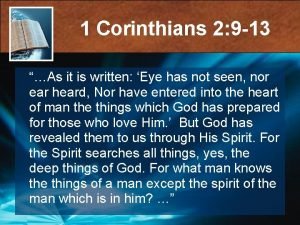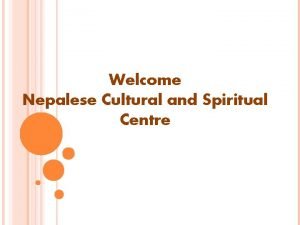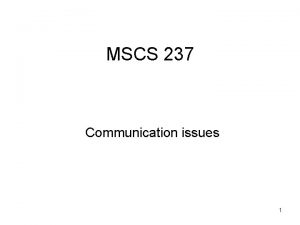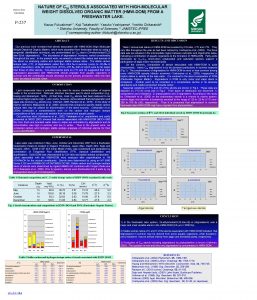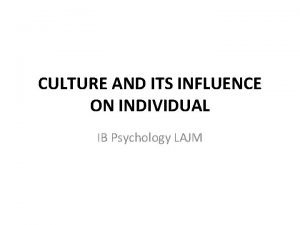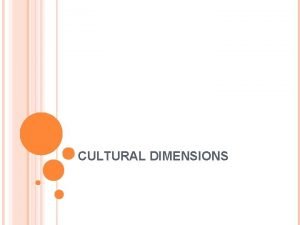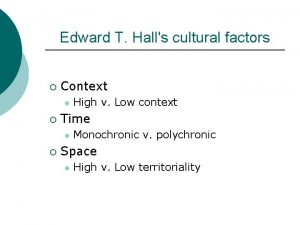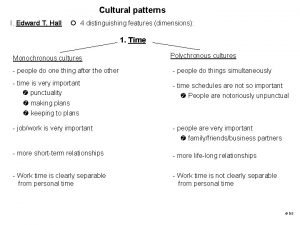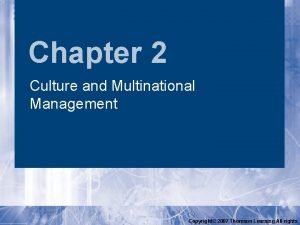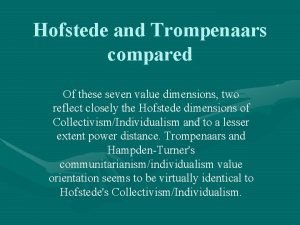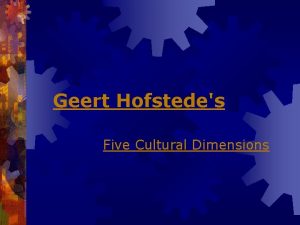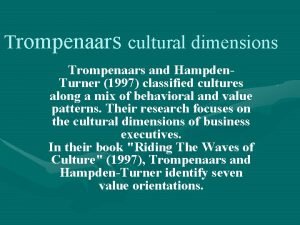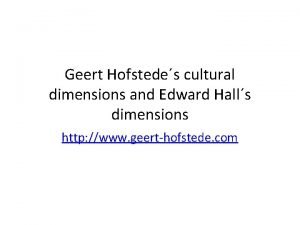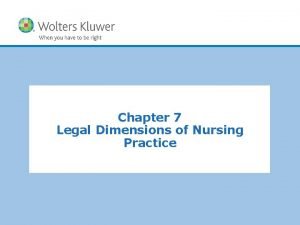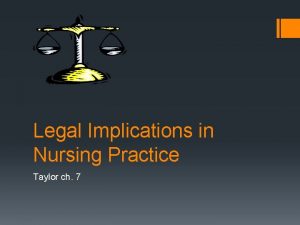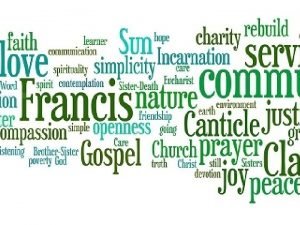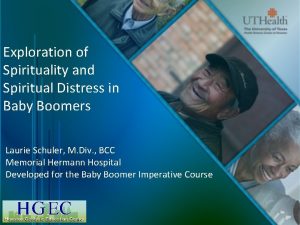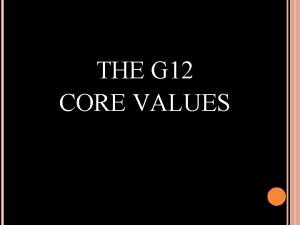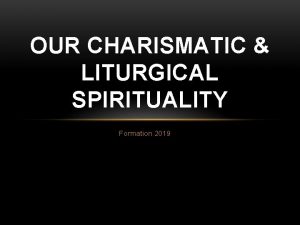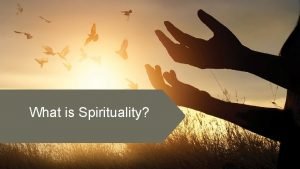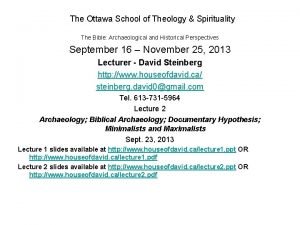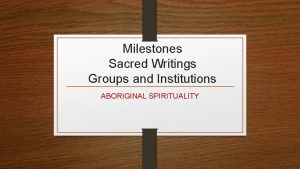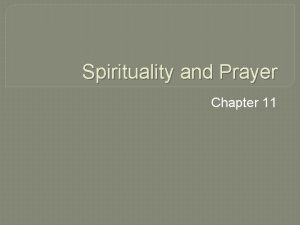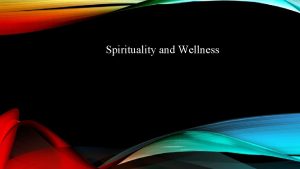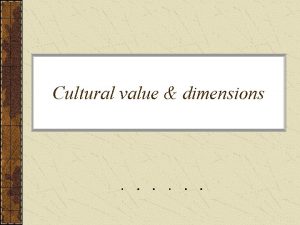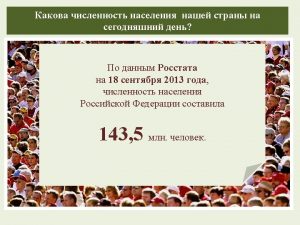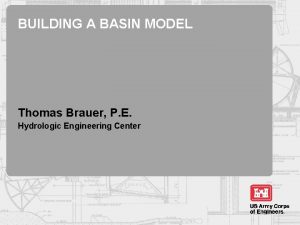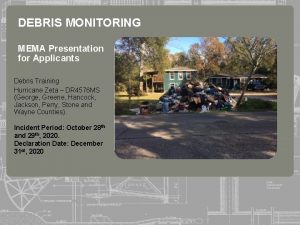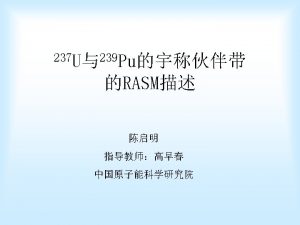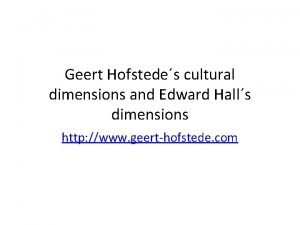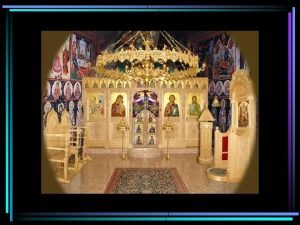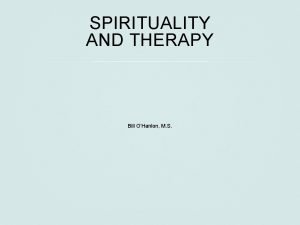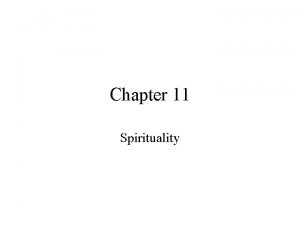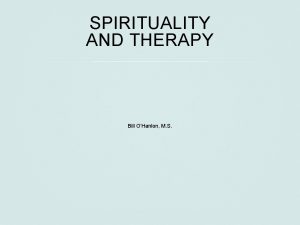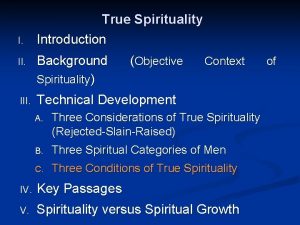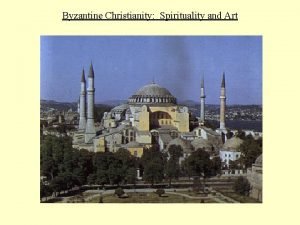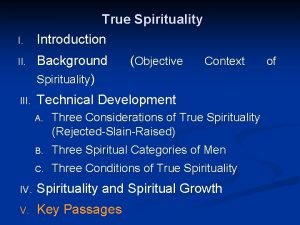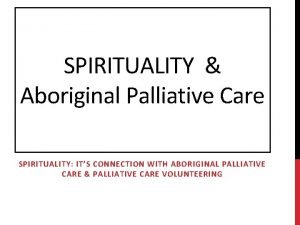Spirituality in Nursing N 237 Cultural Spiritual Dimensions



























- Slides: 27

Spirituality in Nursing N 237 Cultural & Spiritual Dimensions In Healthcare Spirituality in Health Care—an introduction to what is spirituality

Spirituality in Nursing n What is Spirituality? n What is Holistic Nursing? n 3 Characteristics of Spirituality n 3 Phases of Moral Development— Kohlberg n 7 Stages of Faith Development– Fowler n Spiritual Assessment Scale

Definition of Spirituality: n “a broad concept that encompasses values, meaning, & purpose; one turns inward to the human traits of honesty, love, caring, wisdom, imagination, and compassion; existence of a quality of a higher authority, guiding spirit or transcendence that is mystical; a flowing dynamic balance that allows and creates healing of body-mind-spirit; and may or may not involve organized religion” Dossey B. (1988). Nurse as healer: toward an inward journey. In B. M. Dossey, L. Keegan, C. E. Guzzetta, & L. G. Kolkmeier, (Eds. ), Holistic Nursing: a handbook for practice. (pp. 39 -54). Rockville, MD: Aspen.

Definition of “Holistic Nursing” n Overall, Holistic Nursing is supported by and alternately supports the intimate connection of body, mind, and spirit. n The body is the physical substance of a person that can be perceived in empirical reality n The mind is that dimension of an individual that conceptualizes. n The spirit is the life principle that is shared with all humanity and with God.

n “It is the dimension of personhood that drives us to create, love, question, contemplate and transcend. ” Emeth & Greenhut (1991). The Holistic Handbook: care of body, mind and spirit for optimal health. New York: Continuum. n Here is a link to the Standards for Holistic Nursing Practice.

3 Characteristics of Spirituality by Margaret Burkhardt n “Unfolding the mystery”– one’s attempt to understand the meaning & purpose of life. n “Harmonious interconnectedness”– individual’s relationship to other persons &/or to God. n “Inner strength”– relationship to one’s personal spiritual resources and “sense of the sacred”.

The Nurse as Healer n The nurse truly is well situated to be an instrument of healing. From a Christian perspective, this is one interpretation. n “The concept of the nurse as healer incorporates the characteristics of all three definitions; that is, the nurse healer must listen to the voice of God; desire to restore health either of body or of spirit; and attempt to assist the patient in achieving wholeness and integrity of body, mind, and spirit. ” -- O’Brien, M. E. (1999) Spirituality in nursing. Sudbury, MA: Jones & Bartlett, p. 10.

Nursing Theories of CARING n Jean Watson’s Theory of Human Caring has been integral to nursing practice. She describes clinical caritas as a call to care. (http: //www. watsoncaringscience. org/images/features/library/THEORY%20 OF% 20 HUMAN%20 CARING_Website. pdf ) n M. Leininger described caring as the central focus or dimension of nursing practice. (http: //nursing. jbpub. com/sitzman/ch 15 pdf. pdf ) n Sr. Simone Roach postulated 7 attributes of the Caring concept: compassion, conscience, competence, commitment, confidence, comportment & creativity (https: //jaimesorianorn. wordpress. com/lecture-handouts/ )

Dimensions of Caring– Practicing Spiritual Caring– 3 essentials n BEING: being with a sick person without judgment creates space for meaning to emerge and for the holy to be revealed. E. Emeth & J. Greenhut (1991, p. 65).

3 essentials of spiritual caring (cont’d) n LISTENING: Many people are looking for an ear that will listen… He who no longer listens to his brother will soon no longer be listening to God either… One who cannot listen long and patiently will presently be talking beside the point and never really speaking to others, albeit he be not conscious of it. --Dietrich Bonhoeffer (1959). Life together. New York: Harper & Brothers. p. 11

3 essentials of spiritual caring (cont’d) n TOUCHING: “Loving, empathetic, TOUCHING: compassionate touch is perhaps the most vital dimension of nursing theology of caring. ” O’Brien, M. E. (1999) p. 16. It can be physical touch, or verbal

Moral Development (Kohlberg) -- 3 Phases n Preconventional level– early childhood *simple acceptance of right & wrong as identified through punishment or nonpunishment for an act. n Conventional level– later childhood to adolescence *begins as black and white on issues & then develops more abstract understanding of morality n Postconventional level– adulthood *encompassing a societal view of right and wrong

7 Stages of Faith Development (James Fowler) 1. Undifferentiated faith (infancy- 3 years) ü ü Neonates & toddlers are acquiring the fundamental spiritual qualities of trust & mutuality, courage, hope, and love. As they develop and begin to communicate, toddlers develop the use of symbolism that transitions them to the next stage (Taylor, 2002).

7 Stages of Faith Development (James Fowler) cont’d 2. Intuitive- Projective Faith (3 -7 yrs old) ü ü Older toddlers and preschooler live in a world of fantasy and imagination. They imitate and can be powerfully influenced by examples moods, actions & stories of the visible faith Santa Claus is real and God may be perceived as a grandpa depending on how he is portrayed by adults in the child’s life (Taylor, 2002).

7 Stages of Faith Development (James Fowler) cont’d 3. Mythic-Literal Faith (7 -12 yrs old) ü ü ü Children attempt to sort out what is fantasy from what is fact. They want proofs of reality. Stories help this age child learn beliefs and practices of their community. Stories are believed literally rather than with abstract meanings (Taylor, 2002)

7 Stages of Faith Development (James Fowler) cont’d 4. Synthetic-Conventional Faith (13 -20 yrs) ü ü The adolescent & some adults begin to notice the incongruities between stories. It integrates the individual’s experiences beyond the family unit (school, media, the environment around them). Faith synthesizes values and information but also is a basis for identity and outlook. Individuals tend to conform to the beliefs around them because they have not yet reflected or studied them objectively. (Taylor, 2002)

7 Stages of Faith Development (James Fowler) cont’d 5. Individuative-Reflective faith (21 -30 yrs) ü ü ü Young adults and beyond develop a self-identity and worldview that is different from those of others. Individuals form independent commitments, lifestyles, beliefs, and attitudes. Those who obediently attended their parents’ church, or synagogue, or mosque every week, now examine independently what religious practices and beliefs to accept personally.

7 Stages of Faith Development (James Fowler) cont’d 6. Conjunctive Faith (31 -40 yrs) ü ü ü Past mid-life adults find a new appreciation for their past, value inner voices, & become aware of deepseated myths, prejudices, and images that are within them because of their social background. This age may embrace persons of other faith traditions, recognizing that in their faith there may be new understanding. Persons with conjunctive faith strive to unify opposites in mind and experience. (Taylor, 2002)

7 Stages of Faith Development (James Fowler) cont’d 7. Universalizing Faith (41+ yrs) ü ü ü This level of faith if rarely achieved. Fowler describes it as having a sense of an ultimate environment that is inclusive of all being. Such persons have become actualizers of the spirit of a holistic and fulfilled community. Examples of such persons: Mahatma Gandhi Mother Teresa Martin Luther King Taylor, E. J. (2002) Spiritual care—nursing theory, research, and practice. Upper Saddle River, NJ: Prentice Hall.

The Spiritual Assessment Scale — There are numerous Assessment Scales available in the literature. Dossey has included the following 3 dimensions in her model. It avoids religious biases in use of language and offers specific assessment questions for clinical use. 1. Meaning and Purpose 2. Inner Strength 3. Interconnections

The Joint Commission for the Accreditation of Healthcare Organizations J. A. H. C. O. – “Standards Clarification” on spiritual assessment states: “Spiritual assessment should, at a minimum, determine the patient’s denomination, beliefs, and what spiritual practices are important to the patient. This information would assist in determining the impact of spirituality, if any, on the care/services being provided and will identify if any further assessment is needed.

The standards require organizations to define the content and scope of spiritual and other assessments and the qualifications of the individual(s) performing the assessment. ” Therefore, three elements need to be included in a spiritual assessment: • Data Gathering • Assessment of Data • Treatment Planning

Data Gathering: • A basic spiritual assessment should include faith-based data on the patient’s relationship with institutional religious organizations (or alternative spiritually based groups e. g. , 12 -step programs). • The assessment should also include a description of the patient’s belief system. • Finally the assessment needs to identify significant spiritual practices that may impact care.

Assessment of Data: It is not enough to enumerate the patient’s faith, beliefs and practices. A spiritual assessment should also assess the impact of faith, belief and practice on the patient’s understanding of wellness or illness. Further, the assessment should indicate if other assessment is needed (e. g. , assessment of spiritual pain, spiritual injury, moral or ethical issues related to treatment, etc. ).

Treatment Planning: The third element of spiritual assessment is the development of a plan of care that includes provisions for caring for the spiritual needs of the patient. This pastoral or spiritual care plan should be integrated into the Multidisciplinary Treatment Team care plan. Kimble, M. A. (2001). The use of spiritual assessments by the veteran’s administration health care system with regards to dying and death. Retrieved online 7/14/03 Joint Commission directives on Spiritual Assessment

Resources n Bridging Science and Religion: implications for Nursing Practicequalitative research—Look at pp. 476 -477. n Borysenko, J. , & Borysenko, M. (1994). The power of the mind to heal. Carson, CA: Hay House, Inc. n Dossey, B. , Keegan, L. , &Guzzetta, C. (2005). Holistic nursing (4 th ed. )

For as Florence Nightingale asserted so many years ago, “God’s precious gift of life is often placed literally” in the nurse’s hands. This is spirituality in nursing; this is standing on holy ground.
 1 corinthians 2 9-13
1 corinthians 2 9-13 Nepali cultural and spiritual center
Nepali cultural and spiritual center Bu cs 237
Bu cs 237 In a survey of 177 237 u.s. adults
In a survey of 177 237 u.s. adults 230 sayısının birler basamağına yuvarlama
230 sayısının birler basamağına yuvarlama 255-237
255-237 Lesson 4 multiply integers page 237 answers
Lesson 4 multiply integers page 237 answers Local 237 prescription plan
Local 237 prescription plan Imog-237
Imog-237 Acculturation studies ib psychology
Acculturation studies ib psychology Trompenaars seven dimensions of culture
Trompenaars seven dimensions of culture Edward hall cultural dimensions
Edward hall cultural dimensions Hall cultural dimensions
Hall cultural dimensions 7d cultural dimensions model
7d cultural dimensions model Hofstede vs trompenaars
Hofstede vs trompenaars Five cultural dimensions
Five cultural dimensions Trompenaars and hampden-turner cultural dimensions
Trompenaars and hampden-turner cultural dimensions Geert hofstedes
Geert hofstedes Outsourced movie cultural dimensions
Outsourced movie cultural dimensions Legal dimensions of nursing practice
Legal dimensions of nursing practice Legal implications in nursing practice
Legal implications in nursing practice Four pillars of franciscan spirituality
Four pillars of franciscan spirituality Spirituality definition
Spirituality definition G12 core values
G12 core values Liturgical spirituality
Liturgical spirituality Spirituality vs religion
Spirituality vs religion Ottawa school of theology and spirituality
Ottawa school of theology and spirituality Aboriginal spirituality sacred texts
Aboriginal spirituality sacred texts
